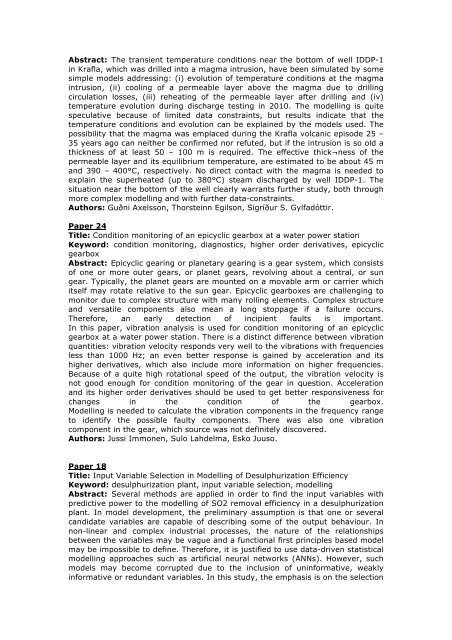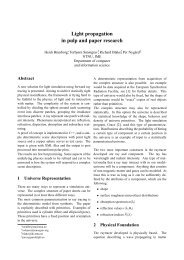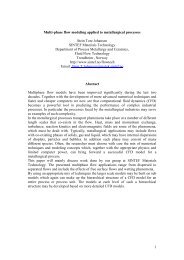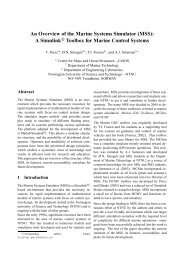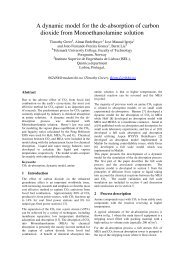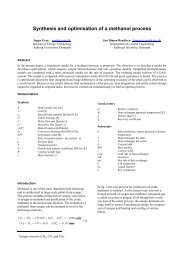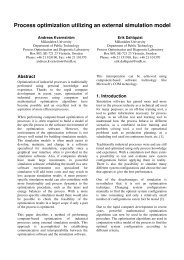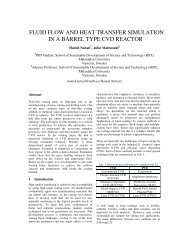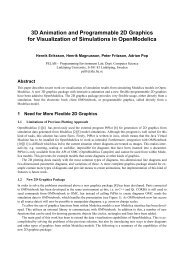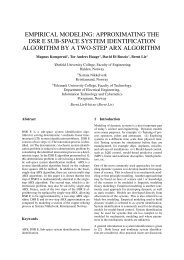detailed programme - SIMS - Scandinavian Simulation Society
detailed programme - SIMS - Scandinavian Simulation Society
detailed programme - SIMS - Scandinavian Simulation Society
You also want an ePaper? Increase the reach of your titles
YUMPU automatically turns print PDFs into web optimized ePapers that Google loves.
Abstract: The transient temperature conditions near the bottom of well IDDP-1<br />
in Krafla, which was drilled into a magma intrusion, have been simulated by some<br />
simple models addressing: (i) evolution of temperature conditions at the magma<br />
intrusion, (ii) cooling of a permeable layer above the magma due to drilling<br />
circulation losses, (iii) reheating of the permeable layer after drilling and (iv)<br />
temperature evolution during discharge testing in 2010. The modelling is quite<br />
speculative because of limited data constraints, but results indicate that the<br />
temperature conditions and evolution can be explained by the models used. The<br />
possibility that the magma was emplaced during the Krafla volcanic episode 25 –<br />
35 years ago can neither be confirmed nor refuted, but if the intrusion is so old a<br />
thickness of at least 50 – 100 m is required. The effective thick¬ness of the<br />
permeable layer and its equilibrium temperature, are estimated to be about 45 m<br />
and 390 – 400°C, respectively. No direct contact with the magma is needed to<br />
explain the superheated (up to 380°C) steam discharged by well IDDP-1. The<br />
situation near the bottom of the well clearly warrants further study, both through<br />
more complex modelling and with further data-constraints.<br />
Authors: Guðni Axelsson, Thorsteinn Egilson, Sigríður S. Gylfadóttir.<br />
Paper 24<br />
Title: Condition monitoring of an epicyclic gearbox at a water power station<br />
Keyword: condition monitoring, diagnostics, higher order derivatives, epicyclic<br />
gearbox<br />
Abstract: Epicyclic gearing or planetary gearing is a gear system, which consists<br />
of one or more outer gears, or planet gears, revolving about a central, or sun<br />
gear. Typically, the planet gears are mounted on a movable arm or carrier which<br />
itself may rotate relative to the sun gear. Epicyclic gearboxes are challenging to<br />
monitor due to complex structure with many rolling elements. Complex structure<br />
and versatile components also mean a long stoppage if a failure occurs.<br />
Therefore, an early detection of incipient faults is important.<br />
In this paper, vibration analysis is used for condition monitoring of an epicyclic<br />
gearbox at a water power station. There is a distinct difference between vibration<br />
quantities: vibration velocity responds very well to the vibrations with frequencies<br />
less than 1000 Hz; an even better response is gained by acceleration and its<br />
higher derivatives, which also include more information on higher frequencies.<br />
Because of a quite high rotational speed of the output, the vibration velocity is<br />
not good enough for condition monitoring of the gear in question. Acceleration<br />
and its higher order derivatives should be used to get better responsiveness for<br />
changes in the condition of the gearbox.<br />
Modelling is needed to calculate the vibration components in the frequency range<br />
to identify the possible faulty components. There was also one vibration<br />
component in the gear, which source was not definitely discovered.<br />
Authors: Jussi Immonen, Sulo Lahdelma, Esko Juuso.<br />
Paper 18<br />
Title: Input Variable Selection in Modelling of Desulphurization Efficiency<br />
Keyword: desulphurization plant, input variable selection, modelling<br />
Abstract: Several methods are applied in order to find the input variables with<br />
predictive power to the modelling of SO2 removal efficiency in a desulphurization<br />
plant. In model development, the preliminary assumption is that one or several<br />
candidate variables are capable of describing some of the output behaviour. In<br />
non-linear and complex industrial processes, the nature of the relationships<br />
between the variables may be vague and a functional first principles based model<br />
may be impossible to define. Therefore, it is justified to use data-driven statistical<br />
modelling approaches such as artificial neural networks (ANNs). However, such<br />
models may become corrupted due to the inclusion of uninformative, weakly<br />
informative or redundant variables. In this study, the emphasis is on the selection


